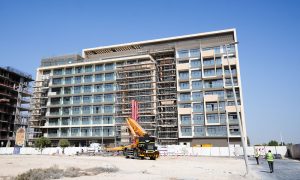Q3 boom in Abu Dhabi, Dubai could sustain momentum in 2014
Industry growth, liquidity and return on investments have led UAE’s property sector to an upsurge in Q3 2013

RELATED ARTICLES: UAE remains international real-estate hotspot | Emiratis to receive $353mn in housing grants | Dubai and Abu Dhabi top destination for construction professionals Industry growth, liquidity and return on investments have led UAE’s property sector to an upsurge in Q3 2013 – a trend it could carry into 2014 and even beyond. While residential rates in Abu Dhabi saw a rise for the first time since the market’s 2008 meltdown, Dubai’s land and property sales were projected at 67% over the same period in 2012. Based on Standard Chartered and Fitch Ratings reports, Masood Al Awar, CEO of Tasweek, predicted that Dubai’s prime property sector would particularly enjoy favorable market conditions through 2014. Abu Dhabi’s rise in rental rates of prime residential units is primarily fueled by strong governmental support for diversified sectors and industries, such as logistics, construction, infrastructure, tourism and hospitality, with areas such as Khalifa City (A and B), Mussafah, Airport Road and Al Ain considered as good options for tenants. Saadiyat Beach, Raha Beach, Bandar and Bateen are some of the higher-end areas in the emirate, whose market is currently in a phase of over-supply. With new supply still in the pipeline, the market-wide vacancy rates are further expected to increase, as per a Tasweek statement. Dubai registered $6.26 bn worth of transactions through the end of July and mortgages also saw similar growth in the same period. Retail rentals and hospitality revenues have grown since 2011 and will continue to do so next year. Residential prices and the demand for Dubai’s prime locations have also risen, with a Standard Chartered report claiming the market growth is driven by strong economic fundamentals than speculation, supported by a strong economic performance, a growing population, rising investor confidence, an improved regulatory environment and anticipation about Dubai’s Expo 2020 bid. They further noted the outperformance of apartment prices and rents as compared to villa prices and rentals – a reversal of market movements from 2012. With more prime projects set to launch in master communities like Jumeirah Village, Business Bay and Dubai Maritime City, developers are expected to report further substantial profit gains in the near future. Office space, besides other market segments, however continue to lag behind Dubai’s residential property prices, a trend predominantly attributed to limited job creation programs and adaptability trimness of corporate structures, causing uneven recovery despite a flourishing, attractive commercial property sector. Transportation and infrastructure, safer returns over various other asset classes, trustworthiness of the market, increased transactions and strong continuous government support were cited as the key drivers for enduring growth by Al Awar and he believes Dubai and Abu Dhabi’s demand as a global real estate hub in Q3 could provide sufficient moment to carry through 2014.























